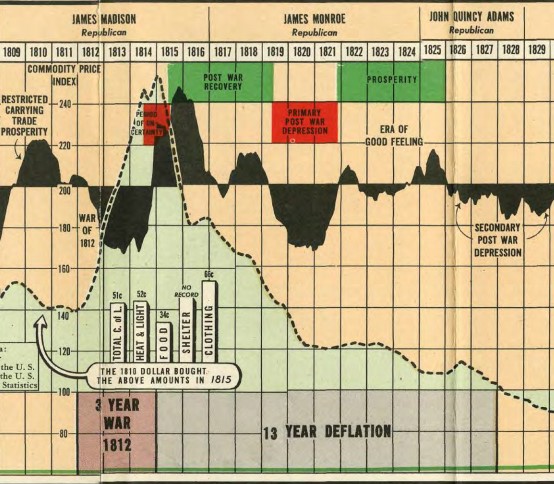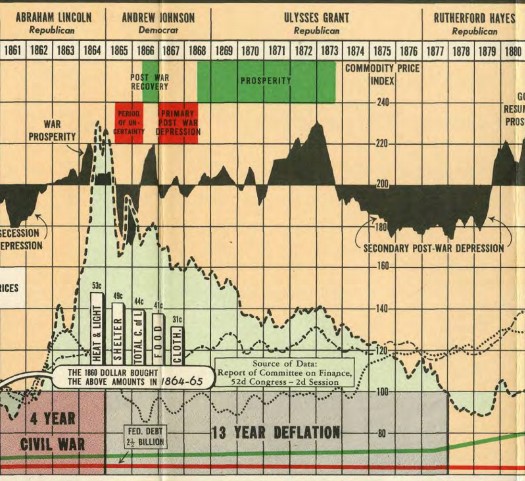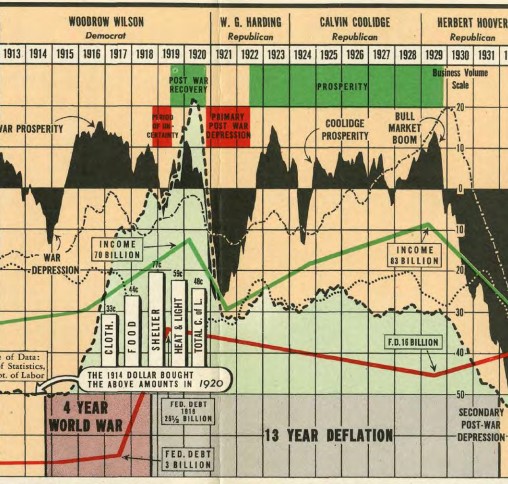Which of the following was an economic change that occurred following World War II?
World War Ii: The Economic Anomaly
For well-nigh 150 years, i of the most important variables in the economic cycle was war.
The cycle looked something similar this:
- Governments would ramp up spending during wartime.
- This spending would increment wages and earnings, thus leading to prosperity.
- All that spending would eventually lead to an inflationary spike.
- Prosperity would inevitably be followed by a hangover once that spending dried up when the wars were over.
- A deflationary depression would follow then the bike would commencement all over again with the onset of the next war.
This occurred during the War of 1812:

The Civil War:

And Earth State of war I:

You lot could basically set your clock to it. The World State of war Two economic playbook started out the same way:

Simply the bicycle changed in the aftermath of WWII.
We got the state of war-time prosperity and inflation just never the deflationary depression on the other side. There was a minor recession in 1945 but never a crash that sent the system reeling. WWII is an economical anomaly that changed the trajectory of the Usa for years to come up in terms of growth, jobs, income, demographics and wealth inequality.
This is the story of why that time was different and how Earth State of war II radically altered the economic landscape for years to come up.
*******
Many of the wealthiest concern magnates in history were born in the same decade, proving timing can exist everything when information technology comes to building empires.
Andrew Carnegie (born in 1835), Jay Gould (1836), J. Pierpont Morgan (1837) and John Rockefeller (1839) all built their empires following the post-Civil State of war industrial economic smash. These titans of industry would usher in the Gilt Age, a menses of rapid economical growth, technological innovation, and industrialization.
This menstruum besides ushed in a huge influx of the working class, just it was mainly a small-scale handful of the upper course that built vast fortunes on the backs of the working course.
The boilerplate annual wage of all American workers in the year 1900 was in the range of $400-$500. Andrew Carnegie fabricated 20,000 times that much the very same year.
Following the Panic of 1907 and depression of 1921, the U.South. economy would go on a tear unlike it had ever seen in the roaring 1920s. Information technology was another period of massive technological innovation with the addition of cars, telephones, movies, radios, and appliances to the consumer landscape.
Unfortunately, past the terminate of the decade, near of the gains had once more gone mainly to the wealthy grade. As the country was just about to caput into the Great Depression in 1929, Brookings Establishment constitute that but 2.three% of American families had incomes of more than than $x,000 a yr. Only eight% made more than $5,000 annually. And more than lxx% of families lived on less than $1,000 a yr. They further estimated that well-nigh 60% of American families had incomes that placed them beneath the poverty line.
If the Gilt Historic period gear up off a new era of wealth inequality, the roaring 20s kicked information technology into overdrive.
When the Great Depression hit, the stock market place crash decimated investors, with stocks falling upward of 85% in less than 3 years. When stocks and valuations ascension as fast as they did in a period such as the late-1920si the initial reaction from most people who follow the markets would be that "everyone" must have been invested at the time. So when the crash hitting, all those noobwhales who jumped in when things were good surely rushed to the exits when things got bad.
But that's just non the case.
At that place were simply 1.5 million or then people invested in stocks in 1929 or a piddling more than one% of the US population.2 It was mostly the wealthy form who were invested in the stock marketplace at the fourth dimension but even with the market place crash, the Groovy Depression had a far greater impact on the lower-income form.
Here'due south how Frederick Lewis Allen described this in his book about the aftermath of the 1920s:
Among the comparatively well-to-do people of the country (those, let u.s. say, whose pre-Depression incomes had been over $5,000 a year) the dandy majority were living on a reduced scale, for bacon cuts had been extensive, especially since 1931, and dividends were dwindling. These people were discharging servants, or cut servants' wages to a minimum, or in some cases "letting" a servant stay on without other compensation than board and lodging. In many pretty houses, wives who had never before—in the revealing current phrase—"washed their ain work" were cooking and scrubbing. Husbands were wearing the former suit longer, resigning from the golf game guild, deciding, perhaps, that this yr the family couldn't afford to go to the beach for the summer, paying seventy-five cents for luncheon instead of a dollar at the restaurant or xxx-five instead of fifty at the lunch counter. When those who had flown high with the stock marketplace in 1929 looked at the stock-market page of the newspapers present their but consoling thought (if they however had any stock left) was that a judicious sale or two would result in such a capital loss that they need pay no income tax at all this year.
The wealthy class was forced to cut back but nigh were still relatively wealthy. It was those who lived beneath the poverty line that had trouble finding piece of work, nutrient, and even shelter.
The New Deal created a series of financial programs, reforms, regulations, and relief that stopped the bleeding from the Great Low but prosperity didn't return until the massive borrowing and defense spending that went into play for WWII.
Because of the technological innovations that were sweeping the land in the early 20th century, the productivity of American business was already taking off in the pb upwardly to the war, even during the dreadful 1930s. Output per hr of work increased by 12% from 1900-1910, vii.5% during the 1910s, 21% during the 1920s and an amazing 41% during the 1930s.
Fifty-fifty with this productivity blast, conviction was notwithstanding low for most business leaders as the scars from the Swell Depression ran deep and then nearly companies still pumped the brakes in terms of operating at or near full capacity. That all changed once the war started.
New plants sprang up on the double to produce tanks, trucks, weapons, and anything else the U.S. government needed for the war. Allen explains how this set off an unprecedented spending spree:
Now, with the coming of the war emergency, the brakes were removed. For the armed forces planners at Washington had conceived their plans on a truly majestic scale. By the end of the state of war the United states had a total of over twelve million men in service, as against less than five million in Earth War I. The devisers of the endeavor had resolved that these forces of ours would exist the best armed, best equipped, all-time supplied, and most comfortably circumstanced in history—which they were. And we had to supply non simply our ain forces, but others also. The outcome, in terms of output and of cost, was astronomical. Past the cease of 1943 we were spending coin at v times the height rate of World War I. During the 19-thirties, critics of the New Deal had become apoplectic over annual federal budgets of seven or eight or nine billions, which they felt were conveying the United States toward bankruptcy; during the fiscal year 1942 we spent, by contrast, over 34 billions; during 1943, 79 billions; during 1944, 95 billions; during 1945, 98 billions; during 1946, 60 billions. For the last iv of these years, in fact, our annual expenditures were greater than the total national debt which had been a matter of such grave concern during the Depression. That national debt had risen from 19 billions in Hoover'due south last twelvemonth in office to 40 billions in 1939—and here was the government, only a few years later, spending upwards to 98 billions per yr, and thus piling the national debt up to 269 billions by 1946! These colossal sums fabricated anything in the previous history of the Us look like small alter.
By 1945, Gdp was 2.4 times the size of the economy in 1939. Allen called it, "the most boggling increment in product that had ever been accomplished in five years in all economic history."
Everyone who wanted a job could discover work. Consumers spent money like crazy, finally letting get of the frugal spending habits that had been ingrained in them since the Not bad Depression. Post-obit one of the worst economic decades in history along with two world wars, it must have been a relief for people to spend some money on themselves for a change.
Surprisingly, this economic nail didn't benefit the wealthy class as much every bit it had in the by. It was the working class who experienced the majority of the gains during the war. The average pay for manufacturing workers was up almost 90% between 1939 and 1945, far outpacing the 29% inflation during that time. And it was people with the lowest incomes who experienced the biggest bang for their cadet.
Hither's Allen again:
Who was getting the money? Generally speaking, the stockholders of the biggest corporations were not getting very much of information technology. These corporations were in many cases getting huge war orders, and thus consolidating their of import positions in the national economy; but excess-profits taxes, forth with managerial caution over the uncertainties of the future, and with the recollection of the embarrassing scandals of 1918 state of war profits, combined to keep their dividend payments at modest rates. The stock market languished. Big capital, as such, was having no heyday.
The principal beneficiaries, more often than not speaking, were farmers; engineers, technicians, and specialists of various sorts whose cognition and ability were especially valuable to the war endeavour in 1 manner or another; and skilled workers in war industries—or unskilled workers capable of learning a skilled merchandise and stepping into the skilled grouping.
What do these figures hateful in human terms? That millions of families in our industrial cities and towns, and on the farms, have been lifted from poverty or near-poverty to a status where they can enjoy what has been traditionally considered a centre-class way of life: decent clothes for all, an opportunity to buy a improve machine, install an electric fridge, provide the housewife with a decently attractive kitchen, go to the dentist, pay insurance premiums, and so on indefinitely.
Non only did the war elevator a large swath of the population into the heart grade, merely information technology also narrowed the gap between the meridian and the bottom in terms of wealth inequality. Between the kickoff of World War I and the end of World State of war Two, the divergence in the share of national income between the elevation 5% of earners and the bottom 95% narrowed from xxx% to 19.5%. The share of the elevation one% brutal from xiii% to vii%. And the disposable income for all Americans rose nearly 75% between 1929 and 1950.
Housing got crushed during the Cracking Low and once more the war was the spark to plow things effectually. Housing starts savage from one million a year to fewer than 100,000 by the time the damage was done. When people returned from the war looking to settle down, housing had a lot of catching upwardly to practice.
A federal housing bill, a baby boom, and the huge number of soldiers coming home looking to settle downwards helped the number of new unmarried-family homes being built abound from 114,000 in 1944 to 937,000 by 1946 and a massive ane.seven million by 1950. Owning a home became the new American dream and basically anyone with a decent task could afford a dwelling by the 1950s.
Globe War Two more than or less created the heart class.
And the babe nail that followed, aided by the GI bill which allowed soldiers to buy their first home and get a college teaching, ensured the middle-class way of life had a potent foundation. The economic system went from a focus on military spending to a focus on consumer spending.
Prices and inflation leveled out and at that place was a 2-decade or so period where things were only near perfect for the stock market place and the economy.
After this goldilocks period of relative economic at-home, we've witnessed many of these trends reverse.
Wage growth has slowed for the middle grade considerably. Inequality in America grows by the year as the gap between the haves and the take nots continues to widen. Inflation in the things we desire (tech) remains subdued merely inflation in the things we need (healthcare, education, housing prices) has made it difficult for many families to get ahead financially.
A number of questions come to heed when thinking through the economic impact of WWII:
- Did WWII interrupt a number of established trends that were already in place?
- Was the growth of the middle class post-obit the state of war an bibelot?
- Is wealth inequality a feature, non a bug, of our capitalist system?
- Do we need some sort of aberrant stupor to the system to narrow the gap betwixt the top and lesser when it comes to wealth inequality?
- Is information technology possible inflation is more often than not a thing of the past if we don't accept any more massive wartime spending booms?
I don't know the answers to these questions because these topics are extremely complex. Simply it's worth because the possibility that WWII changed the economic trajectory of the country.
It's also worth considering how many of those changes have now been wrung out of the system.
Sources:
The Big Change: America Transforms Itself 1900-1950
Since Yesterday: The 1930s in America
The Fifties
Further Reading:
Concern Booms & Depressions: 1775-1943
1In a 3-and-a-half-year period from the 2nd quarter of 1926 through the 3rd quarter of 1929, the Due south&P 500 was upward more than 200%. That'southward an annualized return of nearly 40% per year.
two1 of the biggest reasons that crash was so spectacular is considering so many investors who were in the market took on far too much borrowed money to buy shares. So it didn't have much to wipe them out, causing a cascading of selling.
Source: https://awealthofcommonsense.com/2019/10/world-war-ii-the-economic-anomaly/
Posted by: ballardloffinds.blogspot.com


0 Response to "Which of the following was an economic change that occurred following World War II?"
Post a Comment